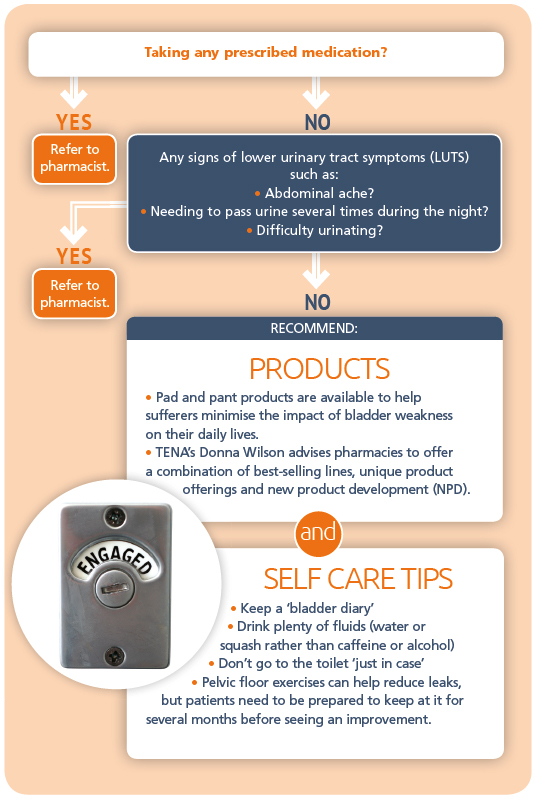OTC

Broaching intimate health
In OTC
Bookmark
Record learning outcomes
Intimate health conditions are common but also sensitive subjects. With the right know-how, pharmacy support staff can navigate difficult patient conversations
From hot flushes to changes in vaginal discharge, there are a number of common women’s health issues that sufferers may find difficult to discuss, leading many women to rely on ‘Dr Google’ instead. However, this is no replacement for the advice and reassurance that pharmacy staff and healthcare professionals can offer, and may cause unwarranted distress – as well as leading to unnecessary visits to GPs and A&E departments.

So what symptoms should women treat themselves, what self care advice can pharmacy teams offer and when should pharmacy teams refer to the pharmacist?
Vaginal discharge
It is normal for women and older girls to have vaginal discharge. This substance, a mixture of liquid, cells and bacteria that is produced in the cervix, lubricates the vagina and helps protect it from infection. Normal discharge will be odourless and clear or white. It is thick and sticky for most of the menstrual cycle, and will be clearer and thinner when a woman is ovulating.
Changes in discharge can be sign there is something wrong. For example:
- Discharge that is thicker than normal can be a sign of thrush, a common yeast infection caused by Candida albicans
- Strong, fishy smelling discharge is often the result of bacterial vaginosis (BV), a condition that, although common, is poorly understood by many sufferers. It occurs when the vagina’s bacterial balance is disrupted, with possible risk factors including using scented soaps, having an intrauterine device (IUD) and being sexually active.
The aim of the consultation should be to eliminate other conditions that should be referred to the pharmacist and to recommend next steps. It can also be a good opportunity to dispel any misconceptions the patient may have, such as believing that BV is the result of poor hygiene, and highlighting the difference between BV and thrush – as the two are commonly confused.
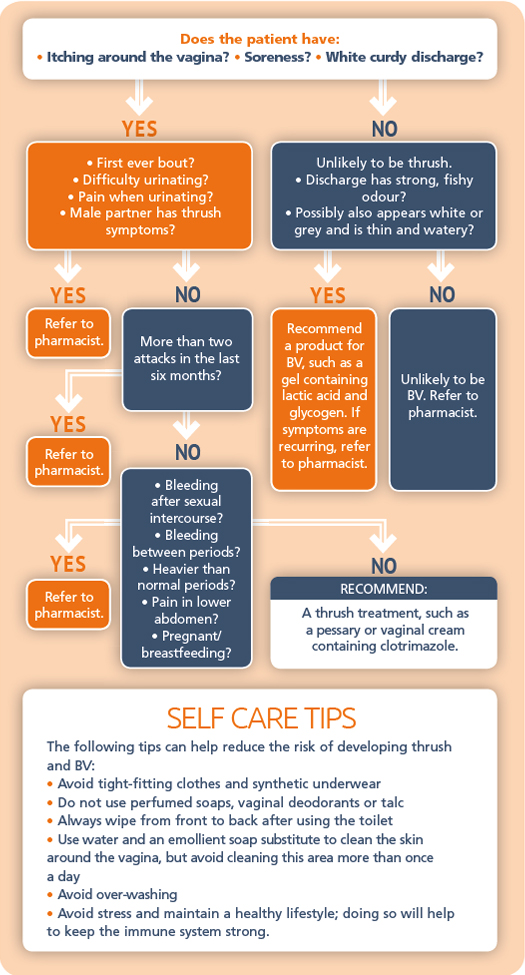
A burning feeling
Painful urination can have several causes, including bladder stones and sexually transmitted infections such as chlamydia. In women, a burning sensation when urinating is often the result of a urinary tract infection (UTI) such as cystitis.
Cystitis occurs when bacteria that normally live harmlessly around the rectum or genitals enter the bladder through the urethra. This can be due to having sex, wiping the bottom from back to front, inserting a tampon or urinary catheter, or using a diaphragm for contraception. Lifestyle triggers can include dehydration and an allergy to certain foods or drinks.
While cystitis is usually an acute condition that resolves with OTC medication, one in five women who suffer from it will get it again. When speaking to women about cystitis, remember that anyone who suffers repeated bouts should be referred to the pharmacist, as they may need to see their GP.
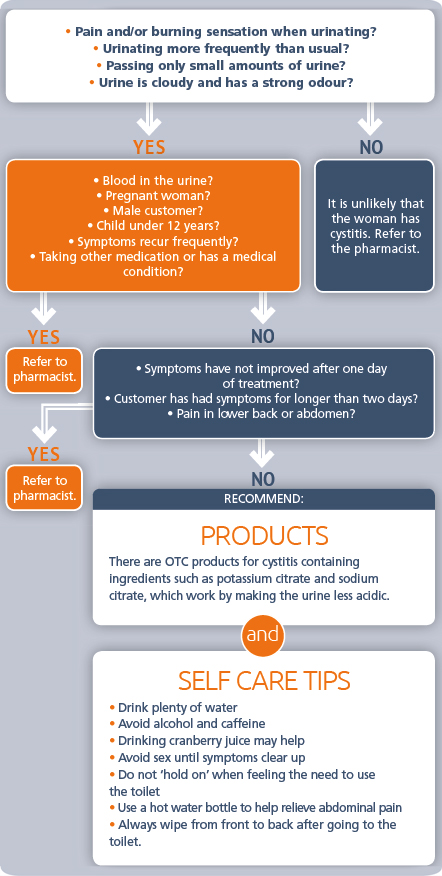
Hot flushes
Hot flushes are a common symptom in women who are approaching menopause, says Numark’s service development pharmacist Lucy Morris, affecting three-quarters of women in this group. Affected women may experience a sudden feeling of heat throughout the body, alongside other symptoms such as sweating and flushing of the face. While for some women this is only an occasional problem, others experience intense flushes several times a day.
Lucy says that while the cause of hot flushes is not fully understood, they are thought to be caused by a drop in oestrogen levels around the time of menopause, sending the false message to the brain that the body is too hot. She adds that potential triggers include spicy foods, caffeine and alcohol, as well as psychological factors such as stress and anxiety.
A patient’s GP may recommend taking hormone replacement therapy (HRT) if they experience frequent, severe flushes.
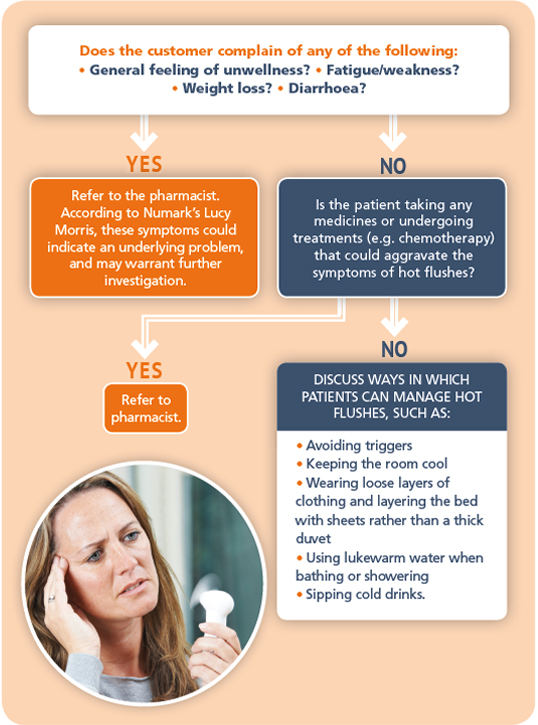
Period pain
Numark’s Lucy Morris says that period pain is common, affecting nine in 10 women at some point. She says that during a woman’s period “the wall of the womb contracts more vigorously, compressing the blood vessels and temporarily cutting off blood and oxygen supply.” This causes the womb to release chemicals that trigger pain.
Period pain usually presents as painful muscle cramps in the stomach. This can spread to the back and thighs. According to NHS Choices, the pain sometimes comes in intense spasms, while at other times there may be a dull, constant ache. Severity of pain can vary with each period.
When speaking to women affected by period pain, or a representative such as a parent, it’s important to note vital information such as the customer’s age and whether they have any other medical conditions that could make their pain worse.
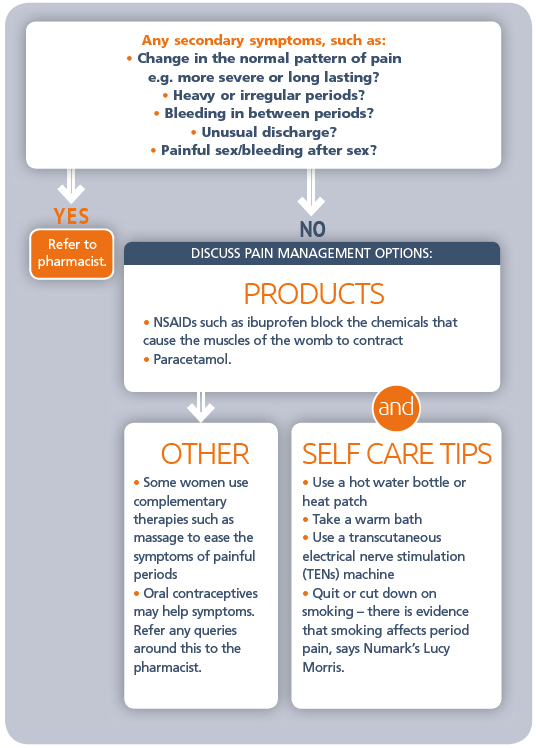
Bladder weakness
According to TENA’s training and brand manager, Donna Wilson, bladder weakness is the biggest category in the intimate hygiene market. Donna says: “As bladder weakness has become increasingly normalised and customers have become more accepting of purpose-made products, its importance to pharmacy has continued to grow.”
Women may be affected by one of several types of urinary incontinence, such as stress incontinence, which can be caused by coughing or laughing; urge incontinence, marked by a sudden, intense urge to urinate; or overflow incontinence, when women are unable to fully empty the bladder, which causes leaking. Some women may experience a mixture of stress and urge urinary incontinence. Numark’s Lucy Morris says that it is important to establish when the patient experiences episodes, as well as other factors such as their age.
Donna advises pharmacy teams to be aware of potential triggers and associated health issues, such as physical and hormonal changes that can come with motherhood or the onset of menopause. When it comes to siting products, she says: “Keep in mind that these are viewed as ‘essential’ products and so should be visible from the front of the pharmacy but in a discreet enough position for those who want to spend a little more time browsing your offering.”
